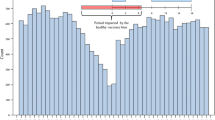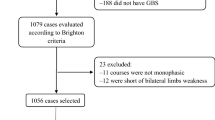Abstract
Introduction
Childhood immunization schedules often involve multiple vaccinations per visit. When increased risk of an adverse event is observed after simultaneous (same-day) vaccinations, it can be difficult to ascertain which triggered the adverse event. This methods paper discusses a systematic process to determine which of the simultaneously administered vaccine(s) are most likely to have caused an observed increase in risk of an adverse event.
Methods
We use an example from the literature where excess risk of seizure was observed 1 day after vaccination, but same-day vaccination patterns made it difficult to discern which vaccine(s) may trigger the adverse event. We illustrate the systematic identification process using a simulation that retained the observed pattern of simultaneous vaccination in an empirical cohort of vaccinated children. We simulated “true” effects for diphtheria–tetanus–acellular pertussis (DTaP) and pneumococcal conjugate (PCV) on risk of seizure the day after vaccination. We varied the independent and interactive effects of vaccines (on the multiplicative scale). After applying the process to simulated data, we evaluated risk of seizure 1 day after vaccination in the empirical cohort.
Results
In all simulations, we were able to determine which vaccines contributed to excess risk. In the empirical data, we narrowed the association with seizure from all vaccines in the schedule to three likely candidates, DTaP, PCV, and/or Haemophilus influenzae type B (HiB) (p < 0.01, attributable risk when all three were administered together: five per 100,000). Disentangling their associations with seizure would require a larger sample or more variation in the combinations administered. When none of these three were administered, no excess risk was observed.
Conclusion
The process outlined could provide valuable information on the magnitude of potential risk from individual and simultaneousvaccinations. Associations should be further investigated with independent data as well as biologically based, statistically independent hypotheses.

Similar content being viewed by others
References
Zhao Z, Smith PJ, Hill HA. Evaluation of potentially achievable vaccination coverage with simultaneous administration of vaccines among children in the United States. Vaccine. 2016;34(27):3030–6.
CDC. Recommended Child and Adolescent Immunization Schedule for ages 18 years or younger: United States 2019. Centers for Disease Control (CDC). https://www.cdc.gov/vaccines/schedules/downloads/child/0-18yrs-child-combined-schedule.pdf. Published 2019. Accessed 29 Oct 2019.
Halperin SA, Tapiero B, Dionne M, et al. Safety and immunogenicity of a toddler dose following an infant series of a hexavalent diphtheria, tetanus, acellular pertussis, inactivated poliovirus, Haemophilus influenzae type b, hepatitis B vaccine administered concurrently or at separate visits with a heptavalent pneumococcal conjugate vaccine. Pediatr Infect Dis J. 2014;33(1):73–80.
Hesley TM, Reisinger KS, Sullivan BJ, et al. Concomitant administration of a bivalent Haemophilus influenzae type b-hepatitis B vaccine, measles-mumps-rubella vaccine and varicella vaccine: safety, tolerability and immunogenicity. Pediatr Infect Dis J. 2004;23(3):240–5.
Yetman RJ, Shepard JS, Duke A, et al. Concomitant administration of hepatitis A vaccine with measles/mumps/rubella/varicella and pneumococcal vaccines in healthy 12- to 23-month-old children. Hum Vaccines Immunother. 2013;9(8):1691–7.
Kawai AT, Martin D, Kulldorff M, et al. Febrile seizures after 2010–2011 trivalent inactivated influenza vaccine. Pediatrics. 2015;136(4):e848–e855855.
Duffy J, Weintraub E, Hambidge SJ, et al. Febrile seizure risk after vaccination in children 6 to 23 months. Pediatrics. 2016;138(1). https://www.ncbi.nlm.nih.gov/pmc/articles/PMC6503849/
McNeil MM, Gee J, Weintraub ES, et al. The Vaccine Safety Datalink: successes and challenges monitoring vaccine safety. Vaccine. 2014;32(42):5390–8.
Sun Y, Christensen J, Hviid A, et al. Risk of febrile seizures and epilepsy after vaccination with diphtheria, tetanus, acellular pertussis, inactivated poliovirus, and Haemophilus influenzae type B. JAMA. 2012;307(8):823–31.
CDC. IIS: Current HL7 Standard Code Set CVX—Vaccines Administered. https://www2a.cdc.gov/vaccines/iis/iisstandards/vaccines.asp?rpt=cvx. Accessed 2016.
Shui IM, Shi P, Dutta-Linn MM, et al. Predictive value of seizure ICD-9 codes for vaccine safety research. Vaccine. 2009;27(39):5307–12.
Syntax: LOGISTIC procedure - model statement. SAS/STAT 9.2 user's guide second edition web site. https://support.sas.com/documentation/cdl/en/statug/63033/HTML/default/viewer.htm#statug_logistic_sect010.htm. Accessed 21 Feb 2019.
Hilton S, Petticrew M, Hunt K. Combined vaccines are like a sudden onslaught to the body's immune system’: parental concerns about vaccine ‘overload’ and ‘immune-vulnerability. Vaccine. 2006;24(20):4321–7.
Rothman KJ, Greenland S, Walker AM. Concepts of interaction. Am J Epidemiol. 1980;112(4):467–70.
Siemiatycki J, Thomas DC. Biological models and statistical interactions: an example from multistage carcinogenesis. Int J Epidemiol. 1981;10(4):383–7.
Millichap J. Patient education: Febrile seizures (Beyond the Basics). 2019.
Walker AM. Orthogonal predictions: follow-up questions for suggestive data. Pharmacoepidemiol Drug Saf. 2010;19(5):529–32.
Author information
Authors and Affiliations
Corresponding author
Ethics declarations
Ethical approval
This study was approved by the Brigham and Women’s Hospital Institutional Review Board.
Funding
This work was supported by a Grant from the Office of Extramural Research, National Institutes of Health (R01AI107721-01 “Methods for Safety Evaluation of Vaccination Schedules”).
Conflict of interest
SVW received salary support as principal investigator to investigator-initiated grants to Brigham and Women’s Hospital from Boehringer Ingelheim, Novartis, and Johnson & Johnson for unrelated work. She is also a consultant to Aetion, Inc., a software company. KS, EL, SRN, BF, MD, JMG, JD, EW, and MK declare they have no conflicts of interest related to the contents of this article.
Data Sharing
Sharing of empirical data is not permissible due to the restrictions of the data use agreement. Simulated data can be requested by contacting the corresponding author.
Electronic supplementary material
Below is the link to the electronic supplementary material.
Rights and permissions
About this article
Cite this article
Wang, S.V., Stefanini, K., Lewis, E. et al. Determining Which of Several Simultaneously Administered Vaccines Increase Risk of an Adverse Event. Drug Saf 43, 1057–1065 (2020). https://doi.org/10.1007/s40264-020-00967-8
Published:
Issue Date:
DOI: https://doi.org/10.1007/s40264-020-00967-8




